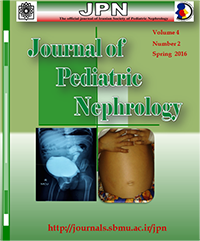Genetic Study of Nephrotic Syndrome in Iranian Children- Systematic Review
Journal of Pediatric Nephrology,
Vol. 4 No. 2 (2016),
4 July 2016,
Page 51-55
https://doi.org/10.22037/jpn.v4i2.10820
Idiopathic nephrotic syndrome is a heterogeneous disease with a spectrum of age at presentation, phenotype, renal pathology, and response to treatment. Many mutations are recognized to be implicated in sporadic or hereditary forms. The aim of this review was to summarize the results of the genetic studies which have already been carried out in Iran considering their limitations.
A literature search was conducted from March 1970 to September 2015 through MEDLINE, EMBASE, Google Scholar, Google, Iran Medex, Magiran, and SID. Eleven studies were relevant. Three articles were excluded due to insufficient data, duplicated case, and a syndromic nephrotic case without genetic studies. Our results showed that in the southwest of Iran, 80% of the patients had mutations in NPHS1 while in Fars Province, one third showed mutations in NPHS2 when all exons were assessed. In two different studies conducted in one center in Tehran, no mutation was detected in exon 5 but when all exons were studied, more than 65% had hot spot mutation in exon 8 of NPHS2. Interestingly, none of adolescents with FSGS showed mutation in p.R229Q (NPHS2, exon 5). This review revealed that both NPHS1 and NPHS2 were prevalent in Iranian children with SRNS. No mutation of p.R229Q was reported in Iranian adolescent with SRNS.
Keywords: Nephrin; NPHS2 protein; Nephrotic Syndrome; Glomerulosclerosis; Focal Segmental.

